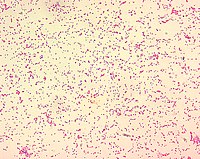
Photo from wikipedia
BackgroundBrucella spp. isolation is increasingly reported in cetaceans, although associated pathologies, including lesions of the musculoskeletal and nervous systems, are less frequently described. Concerning the nervous system, Brucella sp. infection… Click to show full abstract
BackgroundBrucella spp. isolation is increasingly reported in cetaceans, although associated pathologies, including lesions of the musculoskeletal and nervous systems, are less frequently described. Concerning the nervous system, Brucella sp. infection causing meningitis, meningoencephalitis or meningoencephalomyelitis have been extensively reported in striped dolphins (Stenella coeruleoalba), and less frequently in other cetacean species.Case presentationA juvenile female common bottlenose dolphin (Tursiops truncatus) was found stranded alive in Lanzarote (Canary Islands, Spain) in 2005, but died shortly after. On physical examination, the dolphin showed a moderate body condition and was classified as code 2 (fresh dead) at the time of necropsy. The main gross findings were severe multiorgan parasitism, thickened and congested leptomeninges, and (sero)fibrino-suppurative and proliferative arthritis of the shoulder joint. Histopathological examination revealed the distinct features of a sub-acute systemic disease associated with Cetacean Morbillivirus (CeMV) infection. However, brain lesions diverged from those reported in systemic CeMV infection. This led to suspect that there was a coinfecting pathogen, based on the characteristics of the inflammatory response and the lesion distribution pattern in the central nervous system. Brucella sp. was detected in the brain tissue by PCR and Brucella antigen was demonstrated by immunohistochemistry in the brain and shoulder joint lesions.ConclusionsThe zoonotic potential of marine mammal strains of Brucella has been demonstrated both in natural and laboratory conditions. In this study, PCR detected Brucella sp. in the brain of a common bottlenose dolphin stranded in the Canary Islands; the dolphin was also co-infected with CeMV. This is the first detection of Brucella sp. infection in a stranded cetacean in this archipelago. Therefore, we stress the importance of taking adequate measures during the handling of these species to prevent the transmissions of the infection to humans.
Journal Title: BMC Veterinary Research
Year Published: 2019
Link to full text (if available)
Share on Social Media: Sign Up to like & get
recommendations!